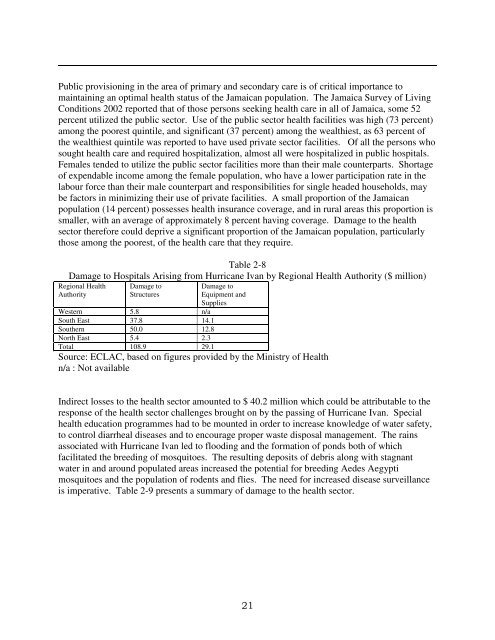Jamaica: Macro-Socio-Economic and Environmental Assessment of ...
Jamaica: Macro-Socio-Economic and Environmental Assessment of ...
Jamaica: Macro-Socio-Economic and Environmental Assessment of ...
Create successful ePaper yourself
Turn your PDF publications into a flip-book with our unique Google optimized e-Paper software.
Public provisioning in the area <strong>of</strong> primary <strong>and</strong> secondary care is <strong>of</strong> critical importance to<br />
maintaining an optimal health status <strong>of</strong> the <strong>Jamaica</strong>n population. The <strong>Jamaica</strong> Survey <strong>of</strong> Living<br />
Conditions 2002 reported that <strong>of</strong> those persons seeking health care in all <strong>of</strong> <strong>Jamaica</strong>, some 52<br />
percent utilized the public sector. Use <strong>of</strong> the public sector health facilities was high (73 percent)<br />
among the poorest quintile, <strong>and</strong> significant (37 percent) among the wealthiest, as 63 percent <strong>of</strong><br />
the wealthiest quintile was reported to have used private sector facilities. Of all the persons who<br />
sought health care <strong>and</strong> required hospitalization, almost all were hospitalized in public hospitals.<br />
Females tended to utilize the public sector facilities more than their male counterparts. Shortage<br />
<strong>of</strong> expendable income among the female population, who have a lower participation rate in the<br />
labour force than their male counterpart <strong>and</strong> responsibilities for single headed households, may<br />
be factors in minimizing their use <strong>of</strong> private facilities. A small proportion <strong>of</strong> the <strong>Jamaica</strong>n<br />
population (14 percent) possesses health insurance coverage, <strong>and</strong> in rural areas this proportion is<br />
smaller, with an average <strong>of</strong> approximately 8 percent having coverage. Damage to the health<br />
sector therefore could deprive a significant proportion <strong>of</strong> the <strong>Jamaica</strong>n population, particularly<br />
those among the poorest, <strong>of</strong> the health care that they require.<br />
Table 2-8<br />
Damage to Hospitals Arising from Hurricane Ivan by Regional Health Authority ($ million)<br />
Regional Health<br />
Authority<br />
Damage to<br />
Structures<br />
Damage to<br />
Equipment <strong>and</strong><br />
Supplies<br />
Western 5.8 n/a<br />
South East 37.8 14.1<br />
Southern 50.0 12.8<br />
North East 5.4 2.3<br />
Total 108.9 29.1<br />
Source: ECLAC, based on figures provided by the Ministry <strong>of</strong> Health<br />
n/a : Not available<br />
Indirect losses to the health sector amounted to $ 40.2 million which could be attributable to the<br />
response <strong>of</strong> the health sector challenges brought on by the passing <strong>of</strong> Hurricane Ivan. Special<br />
health education programmes had to be mounted in order to increase knowledge <strong>of</strong> water safety,<br />
to control diarrheal diseases <strong>and</strong> to encourage proper waste disposal management. The rains<br />
associated with Hurricane Ivan led to flooding <strong>and</strong> the formation <strong>of</strong> ponds both <strong>of</strong> which<br />
facilitated the breeding <strong>of</strong> mosquitoes. The resulting deposits <strong>of</strong> debris along with stagnant<br />
water in <strong>and</strong> around populated areas increased the potential for breeding Aedes Aegypti<br />
mosquitoes <strong>and</strong> the population <strong>of</strong> rodents <strong>and</strong> flies. The need for increased disease surveillance<br />
is imperative. Table 2-9 presents a summary <strong>of</strong> damage to the health sector.<br />
21
















